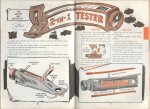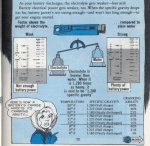- 3,657
- 29
- 48
- Location
- Dallas, Texas
This covers some troubleshooting to diagnose a no-crank issue on a M818 with the Cummins NHC-250.
SITUATION:
The starter is heard to click and engage but the engine does not turn. There might be a sizzling noise or not after a second or two. (do not lean on the starter like that..)
First: Battery checks:
This regards the large size automotive batteries, not 6TL's. 6TL's will behave very similarly though.
See that batteries are charged and have at least 12.5 to 12.6 volts.
It will be necessary to remove some of the cables so each battery can be tested independently. A fully charged battery in good condition has 12.6 volts. Batteries should be allowed to settle for several hours after charging and before testing the voltage. The temperature makes a difference. If it is 60-90 degrees, 12.5-12.65 is OK so here we go.
Charge batteries.
Disconnect one terminal from each of the batteries.
Let sit for 2-3 hours.
Use a Volt meter to check each battery voltage.
All should be at 12.5-12.6 volts and within 0.1 volt of each other.
- If not, some might be weaker, or need service.
- I am sure you service the batteries regularly.
Use a load tester to check the "cranking" power of each battery. It does not matter too much if you use a cheap one or a costly one. Note the cheap one only draws 50-100 amps during the test, and the costly one had a dial and draws as much as 1000 amps. Mine is rated 500 amps. Just follow the directions regarding determining if the battery is OK or not.
If all of the batteries can supply, say, 500 amps for 10 seconds without the voltage going below 12 volts, they are probably new as well as fully charged.. A servicable battery can drop as low as 9-10 volts at 500 Amps after 10 seconds and still crank, but that one will need watching and replacing because it is on its way out.
Now that it is certain the batteries are OK, re-connect them and move to the next item.
Go to the batteries and use the voltmeter to check the 24 volts. Clip the negative lead to ground lead of the battiery. Clip the + lead to the cable going to the starter.
Note the voltage. It should be about 25V. Crank the engine for 1.5 seconds and note the voltage. If it does not drop past 23-24 volts, then there is no load being drawn. If it drops a lot, check the cable ends and clamps for tightness and cleanliness.
If the above test was OK, then go to the starter. Use the meter and connect the NEG proble to the ground cable of the starter. Connect the + probe to the cable from the batteries. I use clip-leads.
Crank for 1.5 seconds. If the voltage reads about the same as at the batteries, the cables are OK. IF not, then do these two checks otherwise skip them:
Go to the starter. Use the meter and connect the NEG proble to the ground cable of the starter. Connect the + probe to the starter-end of the solenoid. Crank for 1.5 seconds. If the voltage is not present at 20-24 volts, and is more like zero, then the solenoid is bad. likely burnt contacts inside. If the voltage goes to 20-24 volts, then the starter is bad.
If in doubt, you can have someone hold the switch in the cranking position (to engage the mechanical gear) and then use a steel bar at your own sole risk to perform a war emergency crank. This is done by shorting across the two large nuts on the solenoid. Use at least a 3/8" bar such as a socket wrench handle. A smaller like a screwdriver bar cannot carry the power and might weld itself in place and cause a fire. In any case do this firmly and abruptly, as the sparks will fly.
Beware the engine is not hyrdo-locked! No amount of cranking power will turn it. This can be determined by trying to turn the engine by hand first. If you are a sissy, use a tool instead of your hand to turn the engine.
SITUATION:
The starter is heard to click and engage but the engine does not turn. There might be a sizzling noise or not after a second or two. (do not lean on the starter like that..)
First: Battery checks:
This regards the large size automotive batteries, not 6TL's. 6TL's will behave very similarly though.
See that batteries are charged and have at least 12.5 to 12.6 volts.
It will be necessary to remove some of the cables so each battery can be tested independently. A fully charged battery in good condition has 12.6 volts. Batteries should be allowed to settle for several hours after charging and before testing the voltage. The temperature makes a difference. If it is 60-90 degrees, 12.5-12.65 is OK so here we go.
Charge batteries.
Disconnect one terminal from each of the batteries.
Let sit for 2-3 hours.
Use a Volt meter to check each battery voltage.
All should be at 12.5-12.6 volts and within 0.1 volt of each other.
- If not, some might be weaker, or need service.
- I am sure you service the batteries regularly.
Use a load tester to check the "cranking" power of each battery. It does not matter too much if you use a cheap one or a costly one. Note the cheap one only draws 50-100 amps during the test, and the costly one had a dial and draws as much as 1000 amps. Mine is rated 500 amps. Just follow the directions regarding determining if the battery is OK or not.
The way the meters work is to apply a known load to the battery and you then notice how much the voltage displayed on the meter decreases. This indicates roughly how much oomph the battery has. For example a sulfated battery will show 12.6 volts all day untill you load-test it. Then it may drop to 8 volts.. The cheap meters therefore do not make as valid a test of CRANKING ability. Cranking is not 50-100 Amps, it is 300-800 Amps.
If all of the batteries can supply, say, 500 amps for 10 seconds without the voltage going below 12 volts, they are probably new as well as fully charged.. A servicable battery can drop as low as 9-10 volts at 500 Amps after 10 seconds and still crank, but that one will need watching and replacing because it is on its way out.
Now that it is certain the batteries are OK, re-connect them and move to the next item.
Go to the batteries and use the voltmeter to check the 24 volts. Clip the negative lead to ground lead of the battiery. Clip the + lead to the cable going to the starter.
Note the voltage. It should be about 25V. Crank the engine for 1.5 seconds and note the voltage. If it does not drop past 23-24 volts, then there is no load being drawn. If it drops a lot, check the cable ends and clamps for tightness and cleanliness.
If the above test was OK, then go to the starter. Use the meter and connect the NEG proble to the ground cable of the starter. Connect the + probe to the cable from the batteries. I use clip-leads.
Crank for 1.5 seconds. If the voltage reads about the same as at the batteries, the cables are OK. IF not, then do these two checks otherwise skip them:
Use a long piece of wire and hook the meter from the batter negative terminal to the starter negative terminal and crank. If there is more than 2 volts difference, the negative cable could be bad, usually at one crimped end or the other.
Use a long piece of wire and hook the meter from the batter positive terminal to the starter positive terminal and crank. If there is more than 2 volts difference, the positive cable could be bad, usually at one crimped end or the other.
Use a long piece of wire and hook the meter from the batter positive terminal to the starter positive terminal and crank. If there is more than 2 volts difference, the positive cable could be bad, usually at one crimped end or the other.
Go to the starter. Use the meter and connect the NEG proble to the ground cable of the starter. Connect the + probe to the starter-end of the solenoid. Crank for 1.5 seconds. If the voltage is not present at 20-24 volts, and is more like zero, then the solenoid is bad. likely burnt contacts inside. If the voltage goes to 20-24 volts, then the starter is bad.
If in doubt, you can have someone hold the switch in the cranking position (to engage the mechanical gear) and then use a steel bar at your own sole risk to perform a war emergency crank. This is done by shorting across the two large nuts on the solenoid. Use at least a 3/8" bar such as a socket wrench handle. A smaller like a screwdriver bar cannot carry the power and might weld itself in place and cause a fire. In any case do this firmly and abruptly, as the sparks will fly.
Beware the engine is not hyrdo-locked! No amount of cranking power will turn it. This can be determined by trying to turn the engine by hand first. If you are a sissy, use a tool instead of your hand to turn the engine.

Last edited:




